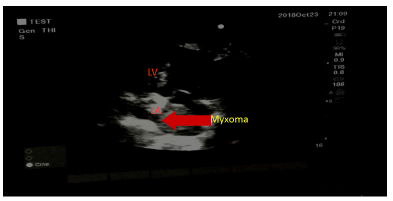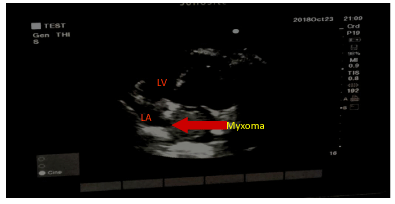Asymptomatic Atrial Myxoma for Modified Radical Mastectomy: What is Priority?
Tejinder Pal Singh1*, Parshotam Lal Gautam1, Sumeet Jain2 and Gurpreet Singh Brar2
1Department of critical care medicine, Dayanand medical college and hospital, Ludhiana, India
2Department of surgical oncology, Dayanand medical college and Hospital, Ludhiana, India
*Address for Correspondence: Tejinder pal singh, Department of critical care medicine, fourth floor, Dayanand medical college and hospital, Ludhiana, India, Tel: +91-947-877-1135; E-mail: tps.ahluwalia83@gmail.com
Submitted: 06 July 2019; Approved: 11 October 2019; Published: 12 October 2019
Citation this article: Singh TP, Gautam PL, Jain S, Brar GS. Asymptomatic Atrial Myxoma for Modified Radical Mastectomy: What is Priority? Int J Hepatol Gastroenterol. 2019; 5(1): 009-011.
Copyright: © 2019 Singh TP, et al. This is an open access article distributed under the Creative Commons Attribution License, which permits unrestricted use, distribution, and reproduction in any medium, provided the original work is properly cited
Download Fulltext PDF
Atrial myxomas are benign primary tumors of the heart but requires excision as definite therapy. Diagnosis of incidental and asymptomatic left atrial myxoma in a patient posted for non-cardiac surgery is a matter of concern and dilemma for operative team as these are potentially known to cause catastrophic complications like intracardiac obstruction and embolism. Debatable issue is the priority for patients undergoing surgery for malignancy. We wish to report a case of left atrial myxoma in a 55 year old female patient of carcinoma breast who underwent uneventful modified radical mastectomy under general anaesthesia.
Introduction
Atrial myxomas are the benign tumors of the heart. Symptoms can be due to embolic events or obstructive valvular dysfunction. Asymptomatic tumors are incidental finding in routine echo cardiography. So when diagnosed, surgical excision of myxoma is recommended as early as possible as these are known to cause life threatening complications like intracardiac obstruction and embolism [1,2]. But at the same time it is very difficult to convince an asymptomatic patient to undergo cardiac surgery first as it is expensive and is associated with significant morbidity particularly in developing countries like India where the patient is spending the expenses of treatment from own pocket and most of the patients belongs to low to middle socioeconomic status.
Case Report
A 55 year old female patient, presented with left breast tumor and was posted for modified radical mastectomy for the same. On examination, she was of moderate built, her weight was 70 kg and height was 159 cm. The base line vitals are recorded with a pulse rate of 76/ min, regular in rhythm and blood pressure of 128/ 84 mmHg. On auscultation, S1 and S2 were heard with normal vesicular breath sounds. On routine echocardiogram there was a large left atrial mass measuring (3.5 cm × 4 cm) arising from the interatrial septum reaching up to mitral valve, opening in diastole. Left ventricular systolic function was normal (Figures 1 & 2).
So a left atrial myxoma was diagnosed incidentally on routine echocardiography without any symptoms and signs associated with it. The past medical history did not revealed any episode of cerebral infarction, syncope or shortness of breath suggestive of embolism. We discussed with surgical team, cardiothoracic team and cardiologist and informed the patient with possible options and outcomes. As the patient was asymptomatic in all postures, secondly on echocardiography myxoma was not saddling on the valve, the team decided to take on the breast surgery as priority to the myxoma surgery. Informed consent was taken and patient was shifted to the operating room, all the routine monitoring started with 5-lead electrocardiogram, pulse oximeter, invasive blood pressure and end tidal capnography. Crash cart with all emergency and antiarrhythmic medications e.g. lignocaine and amiodarone, and the defibrillator were kept ready. Cardiothoracic team was kept in loop. After preoxygenation with 100% oxygen, injection fentanyl 100 micrograms given intravenously and patient was induced with injection propofol 100 mg. Oral intubation was done with injection atracurium 30 mg using 7.5 mm cuffed endotracheal tube. Controlled mechanical ventilation was started with target end tidal CO2 between 30-35 mmHg. Maintenance of anesthesia was done with oxygen, nitrous oxide and sevoflurane. Haemodynamic goal was to keep the heart rate and blood pressure as in resting state and to keep atrial volume adequate so that the myxoma was not saddling on the valve because of changes in cvp. Surgery went uneventful with duration of 130 minutes. After completion of surgery, patient was reversed with injection neostigmine 2.5 mg and glycopyrolate 0.4 mg and extubated. Trans Esophageal Echocardiography (TEE) monitoring during surgery can be helpful for assessment of cardiac structure and function so it was kept standby in this surgery.
Patient was shifted to the post-operative recovery unit for monitoring. Post-operative analgesia was obtained with injection paracetamol 1gm 8 hourly and injection tramadol 100 mg 8 hourly.
Discussion
Myxoma is the most common cardiac tumor [3]. Most of the reported literature is about atrial myxoma for surgical excision of the tumor but ethical justification and decision making for incidental asymptomatic myxoma being scheduled for elective surgery for malignancy has been rarely debated. In the modern medicine era, the patient physician partnership for shared decision making has taken a very important place and patient autonomy takes precedence over other ethical principles. But it also needs to address the possible options with current evidence of literature of different options. Atrial myxoma, as being a rare entity in itself and its coexistence with malignancy, needs thorough evaluation. Decision has to be made keeping in mind the patient’s profile, family’s expectations, surgical team’s experience and institutional multidisciplinary backup. Nearly 90% of myxomas are located in the left atrium, with most of these tumors involving the atrial septum. Clinical manifestations of cardiac myxoma are numerous and complex, without defining characteristics, and traits of cardiac myxomas are dependent on tumor location, size, shape, and growth rate, pedicle length, tumor activity, the shedding of debris (or lack thereof), intratumoral bleeding, degeneration, and/or necrosis, and patient response, among other factors. These tumors can cause chest tightness, shortness of breath, fever, anemia, fatigue, joint pain, weight loss, and even cachexia and other systemic reactions [4]. Sporadic myxoma is the most common form, whereas the familial form is reportedly observed in approximately 7% of cases [5].
Myxomas should be surgically removed as soon as they are diagnosed because of the risks of valve obstruction and systemic embolization and these tumors’ low‐grade malignant tendency. Myxoma may recur in patients with familial tumors or patients who undergo incomplete surgical resection; in particular, recurrence after the surgical resection of primary lesions has been observed in 1 to 4% of sporadic cases and 12 to 22% of familial cases [6].
In our case patient was diagnosed to have breast cancer and during work up incidentally atrial myxoma was diagnosed in echocardiography. The surgical team, cardiothoracic team and cardiologist were kept in the loop. The patient was briefed about all possible options and outcomes. First approach was to do myxoma surgery prior to breast surgery as recommended in literature [7] but the patient refused for this approach because of fear of high cost and morbidity associated with cardiac surgery.
Second approach was to do both cardiac and breast surgeries simultaneously but it has a risk of prolonged postoperative bleeding from surgical site as the patient has to be kept on antiplatelet drugs after myxoma surgery. So the patient refused for this approach also.
Third approach was to do breast surgery prior to myxoma surgery, to which the patient agreed. Hence in this case, the patient has been diagnosed with ca breast along with atrial myxoma which is asymptomatic and incidentally detected, so the patient was more worried about the breast tumor and gave the consent for doing mastectectomy prior to myxoma surgery. Secondly during detailed echocardiographic assessment in various views and angles, it was seen that myxoma is not leading to any obstruction or mitral regurgitation and not showing signs of failure. So the shared decision of the multidisciplinary team and the patient was to do the breast surgery prior to the myxoma surgery.
Till date, the patient is coming to our center for regular follow up, is still asymptomatic and still not opted for myxoma surgery. The reasons may be financial or asymptomatic tumor.
And there are ample of case reports where in this surgery has been done in asymptomatic patients. Maddali et al. [8] reported a case where asymptomatic 54-year-old man was detected with atrial myxoma and coronary artery disease during preoperative assessment for an eye surgery. Nakata et al. [9] reported a case where a pregnant patient at 32 weeks of gestation with atrial myxoma was operated for cesarean section performed under epidural anesthesia. Zeest K et al. [10] presented a case report where the patient had acute respiratory distress due to an undiagnosed atrial myxoma after undergoing knee arthroplasty.
To conclude and as a take home massage, it is feasible to go ahead with urgent and scheduled surgery in asymptomatic atrial myxoma with explained risk. Echocardiographic detailed assessment in various views helps to see the potential obstruction. A shared decision is important in modern medical practice.
- Goz M, Cakir M, Litemur K, Kilinc N, Eren N. Right atrial myxoma in a patient presenting with syncope. Turkish Journal of Thoracic and Cardiovascular Surgery. 2006; 14: 318-319. http://bit.ly/2OCeSpb
- Muroff LR, Johnson PM. Right atrial myxoma presenting as nonresolving pulmonary embolism: a case report. J Nucl Med 1976; 17: 890-892. http://bit.ly/2OJEb97
- Mac Gowan SW, Sidhy P, Aherne T, Luke D, Wood AE, Neligan MC et al. Atrial myxoma: national incidence, diagnosis and surgical management. Isr J Med Sci. 1993; 162: 223-226. http://bit.ly/2onqbHn
- Strecker, T, Agaimy, A, Zelzer, P, Weyand, M, Wachter, DL. Incidental finding of a giant asymptomatic right atrial tumor. Int J Clin Exp Pathol. 2014; 7: 4528-4530. http://bit.ly/2pb1ygS
- Kaya Ö, Ermiş H, Türkkan S, Aytemur ZA, Baysal T, Açıkgöz N. A right atrial myxoma mimicking pulmonary embolism: a case report. Eurasian J Pulmonol. 2014; 16: 40-43. http://bit.ly/2MJ8A4P
- Reynen K. Cardiac myxomas. N Engl J Med. 1995; 333: 1610-1617. http://bit.ly/328hgYL
- Chitwood WR. Clarence Crafoord and the first successful resection of a cardiac myxoma. Ann Thorac Surg. 1992; 54: 997-998. http://bit.ly/2OCKfA1
- Maddali MM, Abduraz AM, Panduranga P, Kurian E. Left atrial myxoma with coronary artery disease: An unexpected preoperative finding-case report. Middle East J Anaesthesiol 2011; 21: 413-417. http://bit.ly/35tgtUy
- Nakata S, Nakano S, Mitsuda N, Itou N, Takahashi Y, Matsuda H. Recurrent left atrial myxoma in a patient with a twin fetus pregnancy. Jpn circ J 1996; 60: 130-132. http://bit.ly/2B3L6Se
- Khan Z, Yang B, Mallidi H, Starre PVD. Acute respiratory distress after knee arthroplasty due to undiagnosed atrial myxoma. Open Journal of Anesthesiology. 2012; 2: 90-92. http://bit.ly/2oyXxTp



Sign up for Article Alerts